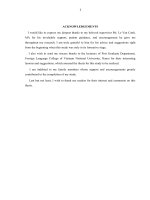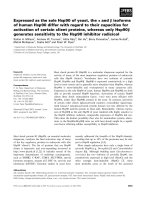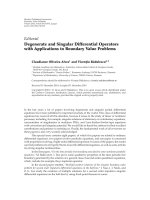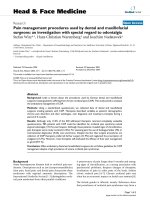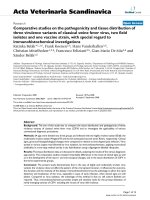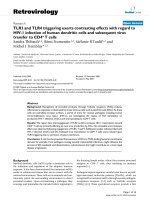Students’ perception on e-learning with regard to online value added courses
Bạn đang xem bản rút gọn của tài liệu. Xem và tải ngay bản đầy đủ của tài liệu tại đây (201.73 KB, 8 trang )
International Journal of Management (IJM)
Volume 11, Issue 3, March 2020, pp. 89–96, Article ID: IJM_11_03_010
Available online at />Journal Impact Factor (2020): 10.1471 (Calculated by GISI) www.jifactor.com
ISSN Print: 0976-6502 and ISSN Online: 0976-6510
© IAEME Publication
Scopus Indexed
STUDENTS’ PERCEPTION ON ELEARNING WITH REGARD TO ONLINE
VALUE ADDED COURSES
P. Kalyanasundaram
Research Scholar, Department of Business Administration, Annamalai University, India
Dr. C. Madhavi
Professor, Department of Business Administration, Annamalai University, India
ABSTRACT
With the advent of development in information and communication technology,
higher education institutions are turning their attention towards course offerings in the
online mode. With the plethora of opportunities that are available, challenges are also
there and organizations are seeking to understand the perspective of the learners. This
paper attempts to study the perception of learners of value added courses that were
offered to students. Students perception towards certificate courses like Forex
Management, Operations Research, Medical Law and Genetics, etc. offered as add-on
value added courses during the graduation through online mode were studied with
regard to usability, user friendliness, navigation, assessment, feedback, course content,
test friendliness etc. Results show that students who opted for online learning felt
optimistic about e-learning.
Keywords: E-learning, Online Mode, Perception, Usability
Cite this Article: P. Kalyanasundaram and Dr. C. Madhavi, Students’ Perception on ELearning With Regard To Online Value Added Courses, International Journal of
Management (IJM), 11 (3), 2020, pp. 89–96.
/>
/>
89
P. Kalyanasundaram and Dr. C. Madhavi
1. INTRODUCTION
According to Drucker (1993) ICT pervades every dimension of our lives. Among various other
fields, education also experiences this trend. By harnessing the potential of ICT we can
positively impact the knowledge levels of students, which can result in elevation of their
knowledge levels by imbibing them with skills and techniques to solve problems that require
analytical and logical thinking that are required by the fierce corporate world. Among the many
beneficial impacts of ICT is the ability of it to hone critical reasoning among learners. In many
developed nations university education is offered even on a mobile phone and India too is not
far behind and the impact is there to be witnessed. The opening up of the economy and the
access to the World Wide Web has thrown open a plethora of opportunities to learners. The
web has had an intense effect on the present day instruction situation and has changed the
manner in which how innovation is utilized for instructive purposes.
The higher education sector is undergoing a metamorphosis in terms of knowledge transfer
and assessments. Though online offerings have not found their way into the mainstream
education in India, there had been a phenomenal change in the way Colleges and Universities
are adopting online platforms and resources. Changes will continue into the future and the use
of online technology is here to stay.
India is in the midst of a technological revolution with ICT permeating every walk of life.
It is a fact that Information and Communication Technologies (ICT) can ensure and expand the
reach and quality of education in India. Currently available online learning opportunities in
India have their own challenges that are faced by higher education institutions that offer these
opportunities and there is a need to understand learner perception on e-learning and the
researcher discusses these in this paper. This study is an attempt by the researcher to study the
perception of students about online learning who underwent an online certificate course during
their undergraduate study as a value-added program along with their regular course.
2. REVIEW OF LITERATURE
The definition of e-learning as per Organization for Economic Cooperation and Development
is the dynamic moving from non or trifle online presence to blended methods and lastly ending
with totally on-line instruction embraced as a replacement to expert learning. E-learning as it is
currently called was first referenced by Jay Cross , CEO of e-learning Forum, a 1200 member
research organization and support gathering, in 1998. As per Urdan and Weggen (2000), elearning is the transaction, obviously, by means of electronic media, for example, web,
intranets, extranets, satellite communicate, sound/video tape, intuitive TV and CD-ROM was
viewed as e-learning.
It is their inference that led to the thought that terms like Web-based, technology based and
electronic learning are characterized and utilized distinctively by various associations and client
groups.
E-learning offers competitive advantages in many ways. Whereas the traditional learning
works on the premises that the instructor owns the knowledge that is passed on to the students,
E-learning authenticates and facilitates the spread of knowledge. Traditional learning suffers
from “narration sickness”, but interactive web-based learning offers scope for the learner to
learn in a participative learning environment where the focus is on ‘learning by doing’. While
educating in a conventional set-up has its own confinements and a customary instructor can
never give 24 x 7 guidance to learners, an e-learning set-up can offer support round the clock
throughout the year.
/>
90
Students’ Perception on E-Learning With Regard To Online Value Added Courses
Fry (2001) is of the opinion that embracement of technology, for example e-learning, is
basic so as to contend in advanced education industry all around and such vital approaches are
useful in business and instructional practice advancements. E-learning has its very own
advantages, for example, it gives numerous possibilities to exchange ideas and information
among the learners and the staff in many forms, including talks, discussion forums, and
messages, which results in an inspired learning environment. Eric Ansong et al (2016) in their
study on determinants of e-learning adoption in Universities found factors like IT infrastructure,
perceived ease of use, expected benefits, organizational compatibility, competitive pressure,
educated partners, content of the course, E-learning curriculum and these were statistically
significant. Any online program should be evaluated on the basis of its learning outcomes by
comparing it with a similar onsite program (Consolacion Fajardo, 2011).
3. METHODOLOGY OF STUDY
Sampling method was used to select respondents. A sample of 120 students was considered for
the study. The objective of the study was to find out their perceptions towards online learning
versus class room learning. A structured questionnaire was used for the purpose of the study. A
25 item instrument was used for this purpose. 16 questions gathered data about perception
statements favoring online learning and 9 questions collected data about perception statements
expressing concern over online learning. Jamovi software was used for the purpose of analyzing
the data collected. Students enrolled in the following programs were contacted for the purpose
of this study: 1. Bio-Informatics; 2. Medical Genetics; 3. Food and Wine Preparation; 4. Fashion
Art and Accessories; 5. Operations Research and Media Management; 6. Animation and
Multimedia; 7. Medical Law and Ethics; 8. Forex, Immigration and Tour Operations
Management. For offering the program the institution had tied-up with a private vendor for
offering one year certificate program on the above mentioned subject areas. The content was
developed by the college and the online hosting and test administration was done by the vendor.
The assessment was done in three stages in the form of Initial Assessment Test a mid-term
assessment called Module Test (MT) at the end of first year of graduation and a final assessment
called Final Evaluation (FE) at the end of second year. The students had the choice of opting or
not opting for the course.
4. RESULTS AND DISCUSSION
Data gathered was tabulated. Out of 120 students surveyed 56 were female (46.7%) and 64
were male (53.3%). Jamovi Software was used for the purpose of analysis. Responses were
collected based on a 5-point scale. A 25 item instrument using Likert Scale was designed. A
widely used measure to ascertain the internal consistency is the Cronbach’s Alpha. The
reliability of the instrument was measured using Cronbach’s alpha which was 0.764. It
is suggested that a minimum level of .7 and above is acceptable. The calculated Cronbach alpha
thus falls in the acceptable range. With regard to the awareness about the online courses 71
students were completely aware about the online courses (59.2%). 40 (33.3%) students were
somewhat aware and 9 students (7.5%) were not aware about the online courses. Therefore we
can say that awareness level about the online courses is good. 101 (84.2%) out of 120 of students
had enrolled for the online courses.
/>
91
P. Kalyanasundaram and Dr. C. Madhavi
Table 1: Students Enrolment for In-house Online Programs
Learner Type
Respondents
%
Course Taken
101
84.2
Not Taken
19
15.8
Total
120
100
Out of the enrolled students, 16 (15.8%) students have not completed the course by taking
the test. The course completion rates are pretty good at 85%.
Table 2: Online Test Taken
Learner Type
Test Taken
Test Not Taken
Total
Course Taken
85
16
101
Not Taken
0
19
19
Total
85
35
120
A t-test was conducted to find out if there is any difference in the mean scores of students
perception toward e-learning between the students (101) who underwent the online courses and
the group of students (19) who did not pursue the online courses. The mean score of students
who took the course was 84.7525, SD=7.63205, SEM= .75942. The mean score of students
who did not take the course was 74.2105, SD=4.82561, SEM=1.10707. An independent sample
t-test yielded results that showed students in the Opted out group (M = 74.2105, SD = 4.82561)
had significantly lower perception scores than students in the online study group (M = 84.7525,
SD = 7.63205), t(118) = 5.795, p < .05.
Learner responses to five key items that relate to the online advantage along with six items
that was related to learner engagement and ease of use in the data collection instrument were
analyzed and the analysis is presented below in Table 3.
/>
92
Students’ Perception on E-Learning With Regard To Online Value Added Courses
Table 3: Item-wise Students Perception regarding Online Learning with reference to students’
preference of online over class room engagement and ease of use /learner engagement
Strongly
Agree
%
Agree
%
No
Opinion
%
Disagree
%
Strongly
Disagree
%
Total
Prefer
Online over
offline
14
13.9
52
51.5
19
18.8
16
15.8
0
0.0
101
Online is
modern
30
29.7
56
55.4
11
10.9
3
3.0
1
1.0
101
Need in
other areas
15
14.9
65
64.4
18
17.8
2
2.0
1
1.0
101
Time spent is
less
12
11.9
64
63.4
14
13.9
10
9.9
1
1.0
101
Immediate
feedback
31
30.7
59
58.4
10
9.9
1
1.0
0
0.0
101
Progress is
easily
monitored
18
17.8
64
63.4
16
15.8
2
2.0
1
1.0
101
Comfortable
to use
10
9.9
41
40.6
29
28.7
20
19.8
1
1.0
101
Convenient
for test
taking
20
19.8
53
52.5
22
21.8
5
5.0
1
1.0
101
Gives
positive
experience
15
14.9
56
55.4
24
23.8
6
5.9
0
0.0
101
Easy
assessment
17
16.8
65
64.4
15
14.9
3
3.0
1
1.0
101
Course is
engaging due
to
multimedia
20
19.8
51
50.5
25
24.8
4
4.0
1
1.0
101
Item
As seen from the above Table 3, the overall perception of the course takers is positive towards
e-learning. With less than 10% opinions highlighting the drawbacks of e-learning, a majority
of the students who take online courses have a positive opinion about the benefits of e-learning.
The areas of improvement would be comfort in terms of use and time consumed where
respondents opined that better multimedia content needs to be there in place and time spent
online is no different than the off line mode.
Table 3 also presents the opinion regarding learner engagement and motivation. With
regard to preference of online over off line, 16 respondents (15.8%) disagreed that online is
better than offline offerings. With regard to the learnability of the course covering multimedia
content, feedback, navigation, course map, repeatability respondents recorded favorable
opinions. About 71 (70.3%) students agreed that the course was engaging due to multimedia
content. 71(70.3%) of respondents opined that the course gave positive experience. 73 (72.3%)
learners said online option was easy to taking tests. 72(71.2%) of students said it was easy to
monitor their learning progress. Almost 90 (89.1%) liked the immediate feedback. All the above
findings vouch for the usability of the online courses.
/>
93
P. Kalyanasundaram and Dr. C. Madhavi
The course takers were given a CD ROM for reference in addition to the online access. The
satisfaction score for CD ROM content with regard to interactivity, multimedia, learning
experience, feedback, and learning expectations was computed. The mean score was 18.97 with
SD = 2.65.
A Chi-Square test of independence was performed to examine the relationship between test
takers and their usage/satisfaction with CD ROM.
Table 4: Satisfaction of users with regard to CD ROM
Test Status
Satisfied with CD
ROM
Not Satisfied with CD
ROM
Marginal Row Totals
Test Taken
50
35
85
Test Not Taken
5
11
16
Marginal ColumnTotals
55
46
101 (Grand Total)
The relationship was significant at p< 0.05. Χ2 (1, N=101) = 4.1279, p = 0.042183. Test
takers are better satisfied than those who do did take the test. It shows that engagement is the
key to satisfaction.
5. SUGGESTIONS AND CONCLUSION
The above study covered a small segment of students who opted for the online courses and
those who did not opt for the courses. The completion rates are good (85%). However we need
to find the reasons for why 15% of the learners did not complete the course. World over the
completion rates for massive open online courses are very less hovering around 7%. In this
study the completion rates are good because these were paid courses and limited to one module.
A study on compelling reasons to pursue and motivation to complete is essential in this context.
One should also note the need for rich multimedia content as required by the students. Better
content in the form of CD ROM etc. should be provided. Those respondents who opted out of
the online courses do not have a favorable opinion about online programs. To make them
understand the benefits of online learning one may give them free access to some modules to
give them a feel of online learning and its benefits. Further studies on learning outcomes on
practical courses like food and wine preparation, fashion arts and accessories may be conducted
to understand whether these skills are really mastered as these courses cannot be offered only
in online mode. They need blended learning as compared to other theory courses that should
include theory as well as practical instructions.
/>
94
Students’ Perception on E-Learning With Regard To Online Value Added Courses
REFERENCES
[1]
Boateng, R., Mbrokoh, A., Boateng, L., Senya, P., & Ansong, E. (2016). Determinants of ELearning Adoption among students of developing countries. International Journal of
Information and Learning Technology, 33(4), 248-262
[2]
Consolacion Fajardo (2011). Evaluation of Learning Outcomes in Undergraduate Onsite and
Online Accounting Courses. The Journal of American Academy of Business, 17(1), 18-24
[3]
Drucker, P.F. (1993). Post-Capitalist Society, Butterworth-Heinemann, Oxford
[4]
Palloff, RM. and Pratt, K. (2003). The Virtual Student: A Profile and Guide to Working with
Online Learners, Jossey-Bass, San Francisco, CA
[5]
Roy Clariana and Patricia Wallace (2002). Paper-based versus computer-based assessment:
key factors associated with the test mode effect. British Journal of Educational Technology.
33(5), 593-602.
[6]
Stephenson, J. (Ed.) (2001). Teaching and Learning Online. Pedagogies for New
Technologies. Kogan Page, London.
[7]
Urdan, T.A. and Weggen, C.C. (2000), Corporate E-Learning: Exploring a New Frontier,
W.R. Hambrecht & Co., San Francisco, CA
[8]
Varian and Shapiro (1999). Information Rules – A Strategic Guide to the Network Economy.
Harvard Business School Press, Boston, MA
[9]
Dr. R.P. Bajpai, Dr. Kapil Singh Hada and Geetanjali Bajpai, Academic Libraries and ELearning: Initiative and Opportunities, Pune, India. International Journal of Library &
Information Science, 5(3), 2016, pp.159–165.
[10]
Obaida Alkhatib and Beenu Mago I, 2017, learning Management System: An Innovative
Approach to E-Learning. International Journal of Information Technology & Management
Information System 8(1), pp. 1-6.
[11]
Yahya Al-Ashmoery, Rochdi Messoussi, Youness Chaabi and Raja Touahni, 2013,
Monitoring And Visualizing Students Tracking Data Online Learning Activities (Tracking
In E-Learning Platforms) Mvsa, International Journal of Information Technology &
Management Information System (IJITMIS), Volume 4, Issue 3, September - December ,
pp. 121-135
[12]
Nathan D’Lima, Anirudh Prabhu, Jaison Joseph and Shamsuddin S. Khan, 2013, Novel
Approach in E-Learning to Imbibe Environmental Awareness, International Journal of
Computer Engineering and Technology (IJCET), Volume 4, Issue 2, March – April , pp.
166-171
/>
95
P. Kalyanasundaram and Dr. C. Madhavi
[13]
Tareq Saeed Ali Thabet and Dr. N.V.Kalyankar, 2014, The Effect of E-Learning Approach
on Students’ Direct Achievement and Delayed Achievement in Fraction Math Course Level
5 At Yemen's Public Primary School, International Journal of Computer Engineering and
Technology (IJCET), Volume 5, Issue 4, April, pp. 73-85
/>
96
